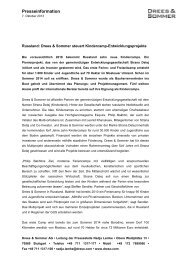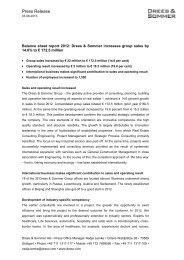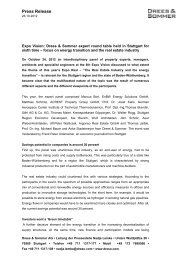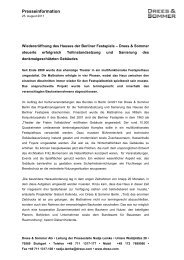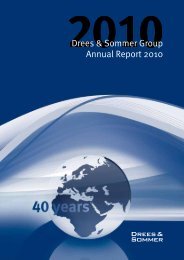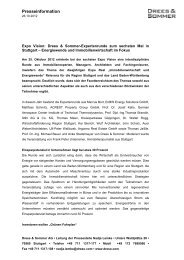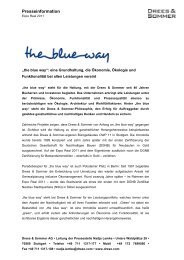Download Annual Report 2012 - Drees & Sommer
Download Annual Report 2012 - Drees & Sommer
Download Annual Report 2012 - Drees & Sommer
You also want an ePaper? Increase the reach of your titles
YUMPU automatically turns print PDFs into web optimized ePapers that Google loves.
loCal-goVernMenT CliMaTe proTeCTion<br />
The city of Ostfildern<br />
takes a long-term approach<br />
to climate protection<br />
“For the first time we, as a local<br />
government, can evaluate our<br />
previous climate protection efforts<br />
on a large scale and coordinate<br />
our future actions. As author of<br />
the overall assessment and the<br />
main initiator of the upcoming<br />
measures <strong>Drees</strong> & <strong>Sommer</strong> has<br />
dramatically advanced our local<br />
climate protection.”<br />
Frank Hettler,<br />
Department of Energy Management Ostfildern<br />
Integrated climate protection concepts are an effective means<br />
for cities and districts that want to systematically reduce greenhouse<br />
gas emissions. <strong>Drees</strong> & <strong>Sommer</strong> has supported the city of Ostfildern<br />
in establishing such a concept, identifying the most effective local<br />
measures. The experts are also helping with implementation.<br />
Methodological process<br />
Phase 1<br />
Initialization<br />
Communication strategy<br />
Kick-off<br />
Stakeholder workshop<br />
Collection and validation of basic data<br />
The European Union’s climate protection<br />
goal is to reduce greenhouse gas<br />
emissions to below 20 percent of 1990<br />
levels by 2020. Local government<br />
authorities can now take measures to<br />
meet such regulatory requirements. One<br />
thing is certain: This ambitious target<br />
does not seem achievable without the<br />
cities and their citizens.<br />
The district of Esslingen is playing an<br />
exemplary role in this respect. The<br />
municipality with a total of six districts<br />
and some 40,000 inhabitants has<br />
been focused on the subject of energy<br />
efficiency for years. In <strong>2012</strong>, the city<br />
decided to strategically pool its efforts<br />
and to continuously reduce climatedamaging<br />
carbon dioxide (CO2) emissions<br />
over the next few years.<br />
The target is a reduction of 16 percent<br />
An integrated climate protection concept<br />
forms the basis for further action. It<br />
covers nearly every aspect of daily life,<br />
from housing to mobility. A team of<br />
engineering and infrastructure experts<br />
from <strong>Drees</strong> & <strong>Sommer</strong> was charged with<br />
its preparation and the necessary preliminary<br />
investigations. The specialists<br />
had already undertaken a related pilot<br />
project for the borough of Nellingen the<br />
previous year.<br />
The main objectives of the Ostfildern<br />
climate protection concept are the<br />
reduction of carbon emissions by<br />
16 percent or 32,000 tonnes and a<br />
significant increase in the share of<br />
renewable energy in households and<br />
industry. <strong>Drees</strong> & <strong>Sommer</strong> was able to<br />
underpin these objectives with concrete<br />
figures: It was established, for example,<br />
that Ostfildern’s households are<br />
responsible for roughly 42 percent of<br />
the carbon emissions and therefore<br />
have a correspondingly very high savings<br />
potential.<br />
Phase 2<br />
Energy and<br />
carbon assessment<br />
Phase 3<br />
Development<br />
of scenarios<br />
and measures<br />
Phase 4<br />
Catalog of<br />
measures<br />
Phase 5<br />
Stabilization and<br />
controlling<br />
Phase 6<br />
Finalization<br />
Classification as prototypical urban, built-up and landscape areas<br />
Determination of current energy demand/consumption<br />
Determination of long-term energy demand<br />
Determination of energy potential<br />
Determination of energy sources<br />
Energy and carbon assessment<br />
Development of scenarios<br />
Clustering scenarios<br />
Determination of carbon-equivalent savings Structuring/in-depth discussions<br />
Potential analysis<br />
Thematic working groups<br />
Profitability analysis<br />
Optimization, prioritization and preparation of catalog of measures<br />
Recommendations<br />
Implementation schedule<br />
Controlling concept<br />
Final report<br />
active public relations and press work, working groups, coordination meetings<br />
26<br />
27



